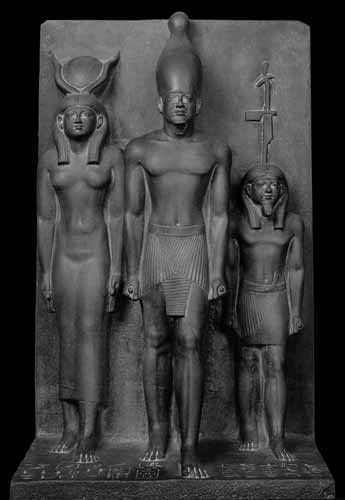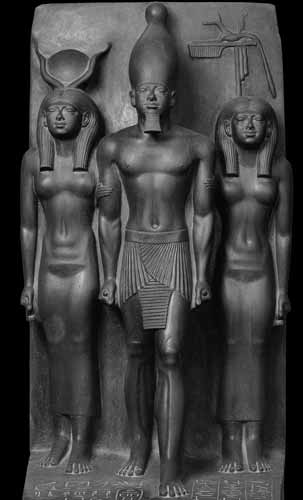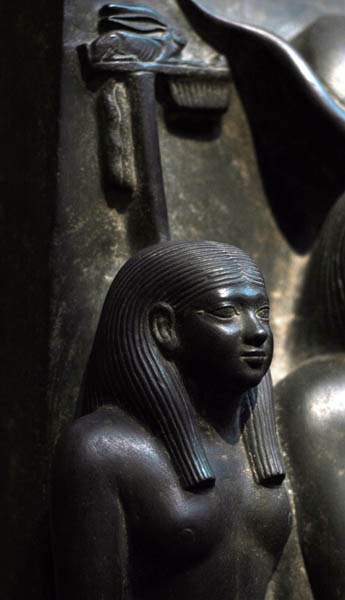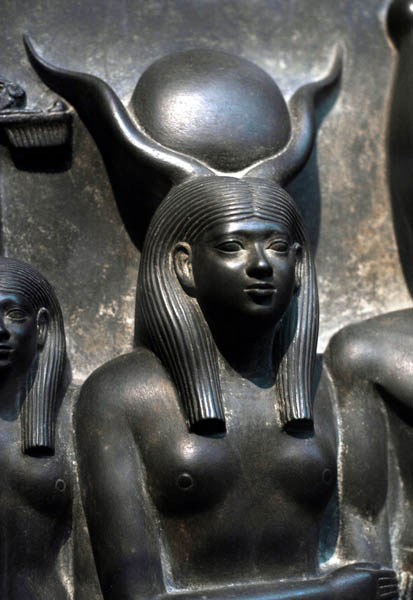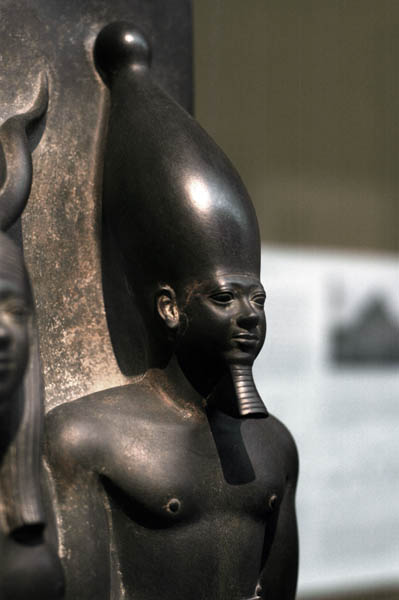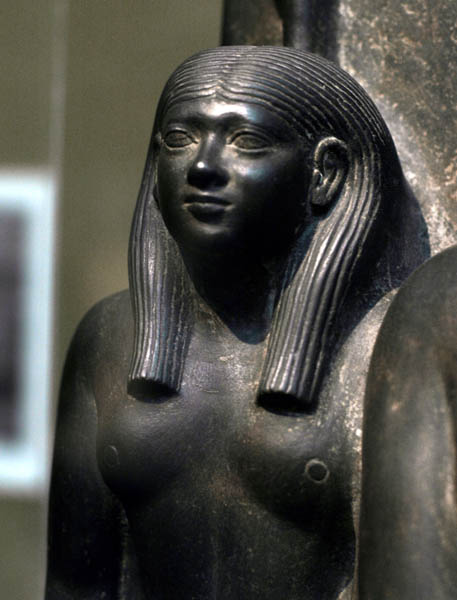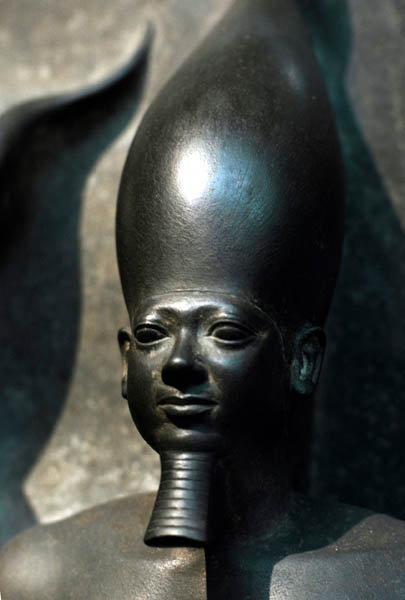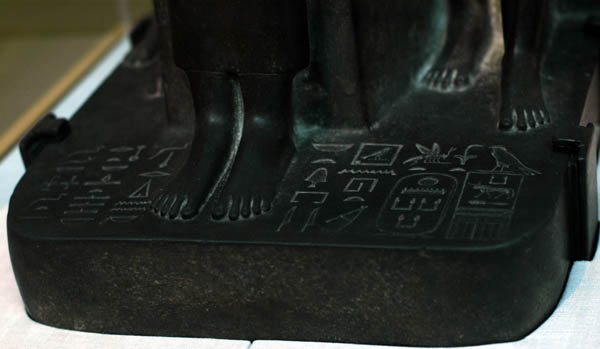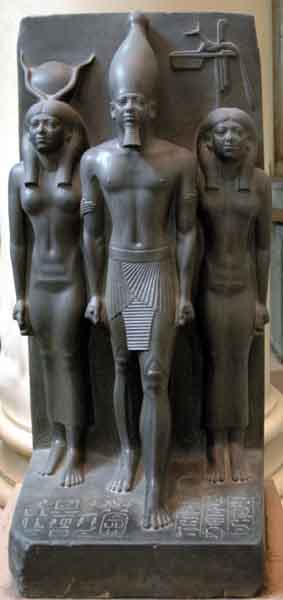-
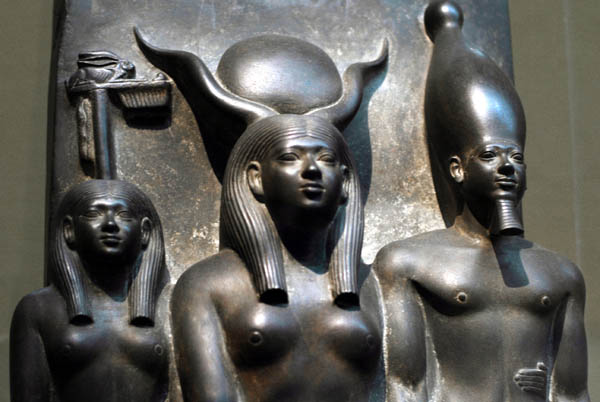
- King Men-Kau-Re, the goddess Hathor and the deified Hare nome
4th Dynasty, reign of Men-Kau-Re, c.2551-2523 BC
Giza, Men-Kau-Re Valley Temple - Greywacke, h.84.5 cm, w.43.5 cm, d.49 cm
- Harvard University-Museum of Fine Arts Expedition 09.200
- George Reisner discovered some of the finest Egyptian sculpture known to exist in the Men-Kau-Re Valley Temple [Reisner 1931, 34-54, 108-115]. An extraordinary pair statue of King Men-Kau-Re and a queen was unearthed there, as well as a series of triads, each depicting the king, the goddess Hathor, and a personified nome god.' The context and precise meaning of the triads is not well understood. According to an early theory, there were originally thirty or more, one for each of the thirty-odd nomes. Their presence in the pyramid complex guaranteed the deceased king a continuous supply of provisions from all regions of the country. A more recent interpretation is that there were eight sculptures, symbolizing the major sites associated with the cult of Hathor.
- All together, four complete triads (MFA Boston 09.200, Cairo JE 46499, JE
40678, and JE 40679), one incomplete triad (MFA Boston 11.3,47), and fragments from a sixth grouping
were recovered from the site.
- The sensitively modelled and beautifully proportioned triad illustrated here is
unique in that Hathor, rather than Men-Kau-Re, dominates the group by her central and forward position
and larger scale. A major deity since Predynastic times, Hathor was the celestial mother of the sun
calf, a guardian of the necropolis, and the protectress of the king. Depicted with gentle curves in
contrast to the block seat and the rectangular slab in the hack, Hathor's left arm embraces Men-Kau-Re's
waist while her right crosses her midsection to rest on the king's arm. This pose is the same (in
reverse) as that of the queen in the pair statue from the same site. The goddess' face is full and
round, with subtle modelling of the eyebrows, folds on the upper eyelids, a small mouth with puckered
lips, and a chin that recedes slightly. Field photography shows black pigment on the eyebrows and around
the eyes. The cosmetic lines extend outward, stopping at the end of the brow. Her headdress, a solar
disc and cow horns, is prominently displayed above an incised, tripartite wig, but the jewellery that
once adorned her sleeveless sheath dress - a wesekh broad-collar with teardrop pendants and a wide hand
bracelet-have largely disappeared. The headdress was not in standard use until Dynasty 5. However, the
solar disk, a symbol of the sun god Re, indicates the increased importance of this deity by the end of
4th Dynasty.
- Men-Kau-Re stands on Hathor's left with his left foot advanced. His remarkably individualized facial features-the prominent eyes, fleshy nose, moustache, and protruding lower lip are all characteristics recognizable on other representations of the king. Unlike the female figures in the group, Men-Kau-Re's musculature is well defined, giving the overall impression of a youthful, athletic, and forceful ruler. His arms are at his sides with the left hand holding a ritual cloth or staff while the right clasps a hafted, ceremonial mace." He wears the white crown of Upper Egypt, a false beard," and a pleated shendyt kilt with belt. A painted neck ornament in the form of a multi-strand, beaded collar and a pair of bracelets once completed his attire.'
Standing to Hathor's right is a personification of the Hermopolite or Hare nome. Each of ancient Egypt's nomes or provinces was associated with a male or female deity." This nome deity wears the Hare standard (a symbol of her district) on her head, and holds an ankh in her left hand. Carved into the base is an inscription that reads: "The Horus Kakhet, King of Upper and Lower Egypt, Men-Kau-Re, beloved of Hathor, Mistress of the Sycamore. Recitation - "I have given you all good things, all offerings, and all provisions in Upper Egypt, forever."'
-
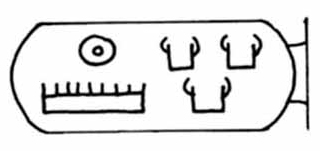 Men-Kau-Re (c. 2551-2523 BC), 5th king of the
4th Dynasty, Old Kingdom. Men-Kau-Re was the throne name of the son of
Khafre and the grandson of Khufu, the 4th and 2nd kings of the 4th
dynasty, respectively.
Men-Kau-Re (c. 2551-2523 BC), 5th king of the
4th Dynasty, Old Kingdom. Men-Kau-Re was the throne name of the son of
Khafre and the grandson of Khufu, the 4th and 2nd kings of the 4th
dynasty, respectively. - He also bore the names:
- Horus name Kachet
- Nebty name Ka
- Golden Falcon name Netjeri
-
 He built the smallest pyramid at the Giza
plateau, which is called "Men-Kau-Re Is Divine." It is the
most southerly of the three huge pyramids built by the 4th Dynasty
Kings. The pyramid is
remarkable because it is the only one of the 4th Dynasty that was
partially constructed of limestone blocks encased in granite.
Men-Kau-Re planned to cover the entire surface with granite, but he
died suddenly; only 16 courses were clad with granite. The pyramid
was completed by his son and successor Shepseskaf, but the temples
had architectural additions that were made during the 5th and 6th
Dynasties. This suggests that the cult of Men-Kau-Re was very
important and perhaps differed from the cults of Khufu and Khafre.
He built the smallest pyramid at the Giza
plateau, which is called "Men-Kau-Re Is Divine." It is the
most southerly of the three huge pyramids built by the 4th Dynasty
Kings. The pyramid is
remarkable because it is the only one of the 4th Dynasty that was
partially constructed of limestone blocks encased in granite.
Men-Kau-Re planned to cover the entire surface with granite, but he
died suddenly; only 16 courses were clad with granite. The pyramid
was completed by his son and successor Shepseskaf, but the temples
had architectural additions that were made during the 5th and 6th
Dynasties. This suggests that the cult of Men-Kau-Re was very
important and perhaps differed from the cults of Khufu and Khafre.
- At the pyramid's entrance, an inscription
records that Men-Kau-Re died on the 23rd day of the 4th month of the
summer and that he built the pyramid. It is thought that this
inscription dates to the time of Khaemwase, high priest of Memphis
and son of Ramesses II, during the 19th Dynasty. Excavations have
revealed a pair of statues of Ramesses II on the south side of
Men-Kau-Re's pyramid. The statues were made of granite; one represents
Ramesses as king, while the other is Re-Atum. The name of Men-Kau-Re
is written in red ocher on the ceiling of the burial chamber of the
middle subsidiary pyramid (QIIIB). Richard H. Vyse (1784-1853) found
a basalt sarcophagus in the main pyramid and, inside it, the
skeleton of a young woman. The sarcophagus was lost in the
Mediterranean between the ports of Catagena and Malta when the ship
Beatrice sank after setting sail on 13 October 1838. The lid from
the wooden anthropoid coffin found inside Men-Kau-Re's pyramid still
exists.
-
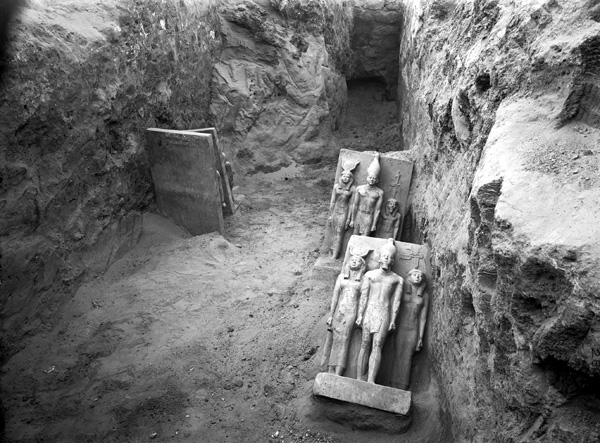 Men-Kau-Re's principal queen was
Khamerernebti II, who is portrayed with him in a group statue that
was found in the valley temple. It is believed that she was buried
in a Giza tomb (GIIIa). Shepseskaf completed the pyramid complex of
his father with mud bricks and left an inscription inside the valley
temple indicating that he built the temple for the memory of his
father. Men-Kau-Re ruled for 18 years. The objects found in some
storage rooms of the temples show that the king's cult was
maintained and that the valley temple also functioned as a palace. A
decree of Antyemsaf of the 6th Dynasty indicates that the valley
temple was in use during his reign; a decree of Pepy II was found on
the valley temple vestibule, awarding privileges to the priests of
the pyramid city. In the adjacent open court and in the area just
east of the temple lie the remains of the Old Kingdom houses. The
personnel responsible for maintaining the cult of the deceased king
lived there. The Giza pyramid complex was used until the end of the
Old Kingdom.
Men-Kau-Re's principal queen was
Khamerernebti II, who is portrayed with him in a group statue that
was found in the valley temple. It is believed that she was buried
in a Giza tomb (GIIIa). Shepseskaf completed the pyramid complex of
his father with mud bricks and left an inscription inside the valley
temple indicating that he built the temple for the memory of his
father. Men-Kau-Re ruled for 18 years. The objects found in some
storage rooms of the temples show that the king's cult was
maintained and that the valley temple also functioned as a palace. A
decree of Antyemsaf of the 6th Dynasty indicates that the valley
temple was in use during his reign; a decree of Pepy II was found on
the valley temple vestibule, awarding privileges to the priests of
the pyramid city. In the adjacent open court and in the area just
east of the temple lie the remains of the Old Kingdom houses. The
personnel responsible for maintaining the cult of the deceased king
lived there. The Giza pyramid complex was used until the end of the
Old Kingdom. -
 The statuary program found inside the
complex displays the superb quality of arts and crafts. The triads
found in Men-Kau-Re's valley temple suggest that his pyramid complex
was dedicated to Re, Hathor, and Horus. In addition, they show the
king's relationship with the gods and are essential to his kingship,
indicating both a temple and palace function. The name of Men-Kau-Re
was found written on scarabs dated to the twenty-sixth dynasty,
which may imply that he was worshiped in that period.
The statuary program found inside the
complex displays the superb quality of arts and crafts. The triads
found in Men-Kau-Re's valley temple suggest that his pyramid complex
was dedicated to Re, Hathor, and Horus. In addition, they show the
king's relationship with the gods and are essential to his kingship,
indicating both a temple and palace function. The name of Men-Kau-Re
was found written on scarabs dated to the twenty-sixth dynasty,
which may imply that he was worshiped in that period.
- Little else known about Men-Kau-Re's reign.
The textual and archaeological evidence of the Old Kingdom indicate
that the palace of Men-Kau-Re was located near his pyramid and not at
Memphis. Men-Kau-Re exploited granite from Aswan and sent expeditions
to Sinai. The Greek historian Herodotus mentioned that Men-Kau-Re died
suddenly and added that there was an oracle from the Buto statue
that foretold that he would live for 6 years. Men-Kau-Re started to
drink and enjoy every moment of his remaining years; however,
Men-Kau-Re lived for 12 years, thus disproving the prophecy. Herodotus
also said that Men-Kau-Re's daughter committed suicide and that the
Egyptians loved Men-Kau-Re more than his father and grandfather. The
Late period tales were based on Men-Kau-Re's reputation during the Old
Kingdom. He ruled with justice, gave freedom to his officials to
carve statues and make offerings, and moderated the firm rules.
- Sources
- The Oxford Encyclopaedia of Ancient Egypt; Donald Redford (Ed) 2001; Oxford University Press, written by Dr Zahi Hawass
- Black and White Images from the Boston Museum's Giza project (see http://www.gizapyramids.org); From Men-Kau-Re's valley temple, four slate triads extracted 11-August-1908.
- The Complete Pyramids; Mark Lehner; 2000; Thames & Hudson
- Egypt in the age of the Pyramids; Markowitz, Haynes and Freed; 2002; MFA Publication
-
 Reisner
had some problems finding Men-Kau-Re's Valley temple. He thought that it
had been covered by shifting sand by the end of the 6th Dynasty and he
needed to use two light rail lines to help removing and dispersing the
sand. The temple is approx 600 Metres from the Mortuary temple and
they are joined by a causeway. The temple was built on the route that
construction materials were brought to Giza - Lehner interprets
this that the builders were aware that this was the last major
construction on this site.
Reisner
had some problems finding Men-Kau-Re's Valley temple. He thought that it
had been covered by shifting sand by the end of the 6th Dynasty and he
needed to use two light rail lines to help removing and dispersing the
sand. The temple is approx 600 Metres from the Mortuary temple and
they are joined by a causeway. The temple was built on the route that
construction materials were brought to Giza - Lehner interprets
this that the builders were aware that this was the last major
construction on this site.
- The temple was the final part of the construction, and was not finished before Men-Kau-Re died. He used large locally quarries limestone to form the foundations, but the superstructure was completed by his successor Shepseskaf in mud brick. During the 6th Dynasty it was re-built by Pepy II, because it was totally ruined by flooding.
- The Triads were found in the magazine area, which is located in the top right of the map behind the Offering Hall.
